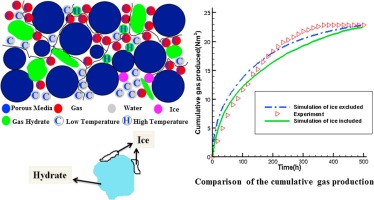Applied Energy ( IF 11.2 ) Pub Date : 2017-10-21 , DOI: 10.1016/j.apenergy.2017.10.013 Minghao Yu , Weizhong Li , Lanlan Jiang , Xin Wang , Mingjun Yang , Yongchen Song

|
As a potential new source of energy, gas hydrate has been the focus of research around the world. In this study, based on a summary of existing models, a one-dimensional mathematical model containing four phases (water, gas, hydrate, and ice phases) and three constituents (water, gas, hydrate) based on the finite difference method (FDM) was established for analysing methane hydrate decomposition at a relatively low temperature condition (approximately 274 K) by depressurization in porous media. This model can be used to investigate gas hydrate exploitation under a wider range of temperatures (e.g., deep seabed or permafrost conditions). When the initial temperature of the hydrate reservoir is approximately 274 K, ice generation occurs during exploitation. This investigation focused on the characteristics of hydrate decomposition, ice generation and ice distribution by changing the parameters of relevant settings. The analysis addressed the effects of ice generation on pressure, temperature, permeability, and cumulative gas production; the influence of other relevant parameters on each other; the influential factors and features of cumulative gas production and the instantaneous gas generation rate. The results showed that ice generation gradually increases during the hydrate decomposition process and occurs early and near the production well due to a large pressure gradient. As an unfavourable factor, ice generation causes the absolute permeability, instantaneous gas generation rate and local pressure to decline. The production well pressure is the determinant of ice generation. Moreover, the final cumulative gas production is determined by the hydrate characteristics, which include the hydrate saturation, reservoir porosity and permeability. Ice generation reduces the gas generation rate, but this does not affect the final cumulative gas production.
中文翻译:

274 K减压下甲烷水合物沉积物产气的数值研究
作为一种潜在的新能源,天然气水合物一直是世界范围内研究的重点。在这项研究中,在总结现有模型的基础上,基于有限差分法(FDM)包含一维数学模型,该模型包含四个相(水,气,水合物和冰相)和三个成分(水,气,水合物)建立)的目的是通过多孔介质中的减压在相对较低的温度条件下(约274 K)分析甲烷水合物的分解。该模型可用于研究在较宽的温度范围内(例如,深海底或多年冻土条件下)开采天然气水合物。当水合物储层的初始温度约为274 K时,在开采过程中会发生冰的生成。这项研究着重于水合物分解的特征,通过更改相关设置的参数来制冰和制冰。该分析解决了制冰对压力,温度,渗透率和累积气体产量的影响;其他相关参数相互之间的影响;影响累计产气量和瞬时产气率的特征和特征。结果表明,由于压力梯度大,在水合物分解过程中,冰的生成逐渐增加,并在生产井的早期和附近发生。作为不利因素,冰的产生导致绝对渗透率,瞬时气体产生速率和局部压力下降。生产井压力是制冰的决定因素。此外,最终的累计气体产量取决于水合物的特性,其中包括水合物饱和度,储层孔隙度和渗透率。制冰会降低气体的产生速率,但这不会影响最终的累积气体产量。



























 京公网安备 11010802027423号
京公网安备 11010802027423号